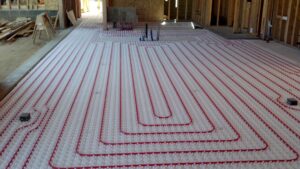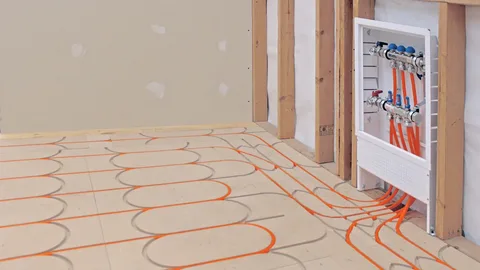Do you want to constantly adjust your thermostat and deal with uneven heating throughout your home? If so, it might be time to consider radiant-heat as a more efficient and effective heating method. Radiant heat offers a unique way to warm up your living space by directly heating objects and surfaces, rather than just the air around them. This blog post will explore the benefits, science, types, installation process, maintenance, costs, energy efficiency, eco-friendliness, and common misconceptions surrounding radiant-heat systems.
Understanding Radiant-Heat and Its Unique Benefits
Radiant-heat stands out as an innovative heating solution that directly warms people and objects in a room, bypassing the conventional method of heating the air. This approach offers many unique advantages, foremost being the ability to achieve a uniform temperature distribution throughout the space. Traditional heating systems often struggle to eliminate cold spots and can lead to a fluctuation in temperature levels, but radiant-heat maintains a consistent warmth, enhancing overall comfort.
This method significantly reduces air movement within rooms, which is particularly beneficial for individuals with allergies or respiratory issues, as it minimises the circulation of dust and other airborne irritants. By opting for radiant-heat, homeowners can enjoy a cosier, healthier living environment and the versatility of installation options, whether it be underfloor, via panels, or through ceiling systems, caters to a wide array of architectural and design preferences, making it a versatile choice for any home.
The Science behind Radiant-Heat
At the heart of radiant-heat lies a remarkably efficient process grounded in the principles of thermal radiation. This heating method leverages electromagnetic waves to transfer heat directly to objects, surfaces, and people within a room without necessitating the intermediary step of heating the air.
Unlike traditional convection-based systems, which rely on circulating warm air (a method that can often lead to significant energy loss and inefficiency), radiant-heat ensures a more direct and thus more economical use of energy. The principle it operates on is akin to the warmth one feels when sunlight streams through a window despite the air outside being cold.
Similarly, radiant-heating elements installed in floors, walls, or ceilings emit infrared radiation that directly warms all objects in the room. These objects, in turn, release the heat back into the room, creating a comfortable and evenly heated environment. This method provides a uniform warmth that is distributed more evenly across the space and significantly reduces air circulation and associated dust particles, contributing to a healthier indoor climate.
Types of Radiant-Heat Systems
Radiant-heat systems encompass diverse solutions, each tailored to meet specific heating requirements and spatial configurations. Among the most prevalent is underfloor heating, where heating elements are discreetly laid beneath the floor surface, ensuring a gentle and uniform heat distribution upwards. This method is particularly favoured for its invisibility and the even warmth it provides across the entire floor area.
Wall-mounted radiant panels offer an alternative, presenting a space-saving solution that can effortlessly integrate into the aesthetic of any room. These panels emit heat that directly warms the surroundings without occupying valuable floor space. Ceiling radiant systems, on the other hand, utilise the overhead space to distribute heat downwards, creating a comfortable and evenly heated environment from above.
Each variant of the radiant-heat system caters to different preferences and architectural designs, allowing for a high degree of flexibility in application and installation. The choice between these systems hinges on factors such as the specific heating requirements of the space, structural considerations, and personal preference, enabling homeowners to tailor their heating solution to match their needs perfectly.
 Radiant heatInstallation Process and Considerations
Radiant heatInstallation Process and Considerations
Installing a radiant-heat system demands thoughtful consideration of various pivotal factors influencing its efficacy and performance. The type of radiant-heat system selected—underfloor, wall-mounted panels, or ceiling systems—dictates distinct installation methodologies. For instance, underfloor heating installation typically occurs during the construction phase or as part of extensive refurbishments, as it involves embedding heating elements beneath the flooring material.
Conversely, radiant panels and ceiling systems offer flexibility, as they can be integrated into existing structures, making them ideal for retrofit projects. The key to the installation process is a comprehensive evaluation of the property’s insulation standards. Adequate insulation is paramount to maximising the efficiency of radiant-heat systems, ensuring that the generated warmth is retained within the space and not lost to the surroundings.
To navigate these considerations effectively, it is advisable to engage with a professional installer who possesses a deep understanding of radiant-heat systems. They can provide tailored advice on the optimal system configuration and ensure that the installation aligns with the home’s unique architectural features and heating requirements.
Maintenance and Longevity of Radiant Heat Systems
One of the appealing aspects of radiant-heat systems is their minimal maintenance requirements and impressive longevity. These systems are designed for durability and, when installed correctly, can provide warmth and comfort for decades.
Regular Inspections
It’s advisable to conduct periodic inspections of your radiant-heat system, mainly if you’re using a hydronic (water-based) system. Checking for leaks or signs of wear and tear in the tubing can prevent minor issues from escalating. Ensuring the wiring and components are in good condition for electric radiant systems is essential for safety and efficiency.
Optimising System Performance
While radiant heat systems require significantly less maintenance than traditional heating systems, monitoring their efficiency can help optimise their performance. This includes adjusting the thermostat settings according to your schedule and seasonal changes.
Professional Servicing
Although minimal, professional servicing is recommended, especially for hydronic systems, to ensure that the boiler and other mechanical components function correctly. This can help extend the system’s lifespan and maintain its efficiency.
Flooring Considerations
Since a significant part of underfloor radiant-heat systems lies beneath your flooring, choosing materials that conduct and hold heat well, like tile or concrete, can enhance the system’s effectiveness and durability. It’s also worth noting that professional assistance may be required to ensure the radiant-heat system is not damaged if the flooring needs to be replaced.
Comparing Costs and Energy Efficiency
Installing a radiant-heat system is a substantial financial commitment compared to conventional heating methods. However, it is imperative to delve into the long-term savings it affords due to its superior energy efficiency. Radiant-heat installations directly target the living spaces and objects within, rather than wasting energy on heating unused areas or cycling through extensive ductwork.
This direct approach ensures that warmth is felt more quickly and retained longer, leading to a notable reduction in energy usage. The subsequent decrease in utility bills offsets the financial outlay for setting up a radiant-heat system. Households utilising radiant-heat can anticipate a more economical operation, as these systems require less energy to achieve and maintain the desired temperature than their traditional counterparts.
The energy savings accrued over time contribute significantly towards recouping the initial investment. Moreover, radiant-heat systems exemplify an eco-conscious heating solution. Their efficiency translates into reduced consumption of natural resources, which is beneficial for the environment and aligns with the growing trend towards sustainable living practices.
Radiant-Heat: Eco-Friendly and Effective
Radiant-heat systems exemplify an environmentally conscious choice for homeowners keen on reducing their ecological impact. These systems excel in energy conservation, directly heating objects and individuals in a space and eliminating the inefficiencies associated with traditional heating methods. By focusing on warmth where it is needed most, these systems avoid the wastefulness of heating unoccupied areas or losing heat through extensive ducting networks?
Such precise and targeted heating conserves energy and significantly diminishes reliance on fossil fuels or electricity generated from non-renewable sources. Consequently, adopting radiant-heat contributes to a marked reduction in greenhouse gas emissions, aligning with global efforts to mitigate climate change.
Furthermore, the compatibility of radiant-heat systems with renewable energy sources, such as solar power, enhances their eco-friendly credentials, offering a sustainable solution to residential heating. By prioritising radiant-heat, homeowners take a proactive step towards fostering a healthier planet, underscoring the system’s role in promoting sustainable living practices without compromising warmth or comfort. This forward-thinking approach to home heating reiterates the viability of radiant-heat systems as a cornerstone of eco-conscious residential design.
Overcoming Common Misconceptions about Radiant-Heat
Numerous myths surround radiant-heat systems, often deterring homeowners from exploring this advantageous heating solution. One prevalent myth is the perception that radiant-heat installations are excessively disruptive and only suited to new builds or extensive renovations. This belief overlooks the versatility of modern radiant-heat systems, which can be seamlessly incorporated into existing structures with minimal alteration. It offers a practical option for those wishing to upgrade their heating without undertaking a major construction project.
Another common misunderstanding pertains to the operational costs associated with radiant-heat. Although the initial investment may be higher than traditional heating systems, the long-term efficiency and energy savings achievable with radiant-heat significantly mitigate these upfront costs. The misconception that radiant-heat is expensive to run fails to account for the system’s ability to lower utility bills through its precise and efficient heating methodology.
It’s also mistakenly believed that radiant-heat requires frequent and costly maintenance. The systems are designed for durability and require minimal upkeep, enhancing their cost-effectiveness and appeal. Dispelling these myths is crucial in recognising the full potential of radiant-heat as a superior, economically viable, and convenient heating solution for a wide variety of homes.
Conclusion
In summary, adopting radiant-heat systems presents a forward-looking approach to home heating, marrying efficiency with environmental stewardship. By dispelling common myths and understanding the tangible benefits—from enhanced comfort to significant energy savings—homeowners are poised to make informed decisions. Radiant-heat redefines the essence of home warmth and aligns with the evolving demands of sustainable living, offering a viable solution for those seeking to reduce their ecological footprint whilst maintaining an optimal living environment.
FAQs
What are the advantages of radiant-heat over traditional heating systems?
Radiant-heat offers several advantages, including more efficient heating due to reduced heat loss, improved indoor air quality as it doesn’t circulate allergens and dust, silent operation, and creating zones for customized heating control, leading to potential energy savings.
Can radiant-heat be installed in existing homes?
Yes, radiant-heat systems can be installed in existing homes. While it may require some modifications to the floors, walls, or ceilings depending on the type of system chosen, retrofitting radiant-heat is feasible. It can provide efficient and comfortable heating without significant disruptions.
What types of radiant heat systems are available?
There are several types of radiant heat systems, including hydronic radiant-heat, which uses hot water flowing through tubes installed beneath the floor; electric radiant-heat, which uses electric coils or mats installed under flooring; and radiant panels mounted on walls or ceilings that emit infrared radiation.
Is radiant-heat suitable for all climates?
Radiant-heat is suitable for most climates, including cold climates, as it effectively warms objects and surfaces regardless of outdoor temperatures. However, heating may be necessary to ensure frigid climates and adequate warmth, especially in poorly insulated spaces.
Are there any maintenance requirements for radiant-heat systems?
Radiant-heat systems generally require minimal maintenance compared to traditional heating systems. Periodic inspections to check for leaks and ensure proper insulation and clean components may be necessary to maintain optimal performance, but routine maintenance is typically straightforward.
| Other Good Articles to Read |
| Skank Blogs |
| Unreal Blogs |
| Tba Blogs |
| All City Forums |
| Dany Blogs |
| Refuge Blogs |
| The Music Blogs |
| Key Forums |
| The Big Blog Theory |
| Joe Blogs |
| Blogs 4 Me |
| Blogs Emon |
| Related Business Listings |
| Contact Directory |
| Local Business Profiles |

